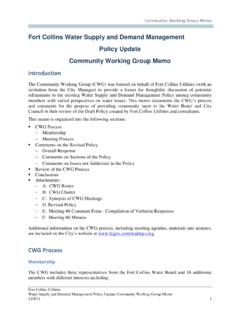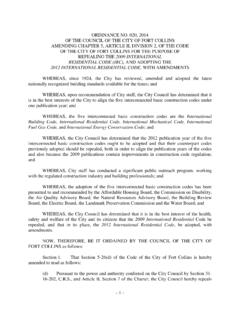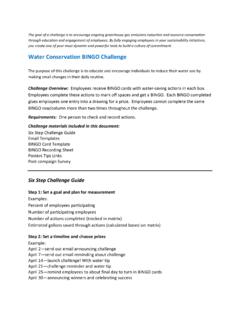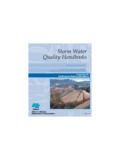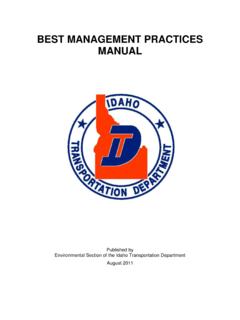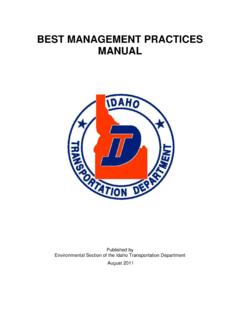Transcription of City of Fort Collins Parks and Recreation
1 City of fort Collins Parks and Recreation Environmental best management practices manual 2011. Index Environmental best management practices manual Executive Summary 01. Chapter One: Introduction and Purpose 03. Chapter Two: best management practices for Site Selection 04. - Farmland Protection 04. - Protect floodplain functions 05. - Preserve wetlands 06. - Preserve threatened or endangered species and their habitats 07. - Select brownfields or greyfields for redevelopment 08. Select sites within existing communities 09. Alternative modes of transportation 10. Chapter Three: best management practices for Design 11. Conduct a pre-design site assessment for site sustainability 11. Use an integrated site development process 12. Engage users and other stakeholders in site design 13. - Reduce potable water use for landscape irrigation 14. Protect and restore riparian, wetland, and shoreline buffers 15. Rehabilitate lost streams, wetlands, and shorelines 16.
2 Manage stormwater on site 17. Water quality 18. Integrate rainwater/stormwater into the design 19. Maintain water features to conserve water and other resources 19. Control and manage known invasive plants on site 20. Use appropriate, non-invasive plants 21. Create a soil management plan and minimize soil disturbance 22. Preserve all vegetation designated as special status 23. Preserve or restore appropriate plant biomass on site 24. Use native plants 25. Preserve plant communities native to the eco-region 26. Restore plant communities native to the eco-region 26. Use vegetation to minimize building heating requirements 27. Use vegetation to minimize building cooling requirements 28. Reduce urban heat island effects 28. Reduce the risk of catastrophic wildfire 29. Eliminate the use of wood from threatened tree species 30. Maintain on-site structures, hardscape, and landscape amenities 31. Design for deconstruction and disassembly 31.
3 Reuse salvaged materials and plants 32. Use recycled content materials 33. Use certified wood 33. Use regional materials 34. Use adhesives, sealants, paints, and coating with reduced VOC emissions 35. Support sustainable practices in plant production 35. Support sustainable practices in materials manufacturing 36. Promote equitable site development 37. Promote equitable site use 37. Promote sustainability awareness and education 38. Protect and maintain unique cultural and historical places 39. Provide for optimum site accessibility, safety, and wayfinding 40. Provide opportunities for outdoor physical activities 41. Provide views of vegetation and quiet outdoor spaces for mental restoration 41. Provide outdoor spaces for social interaction 42. Reduce light pollution 43. Chapter Four: best management practices for Construction 44. Control and retain construction pollutants 44. Restore soils disturbed during construction 45.
4 Restore soils disturbed by pervious development 46. Divert construction and demolition materials from disposal 46. Reuse or recycle materials generated during construction 47. Minimize generation of GHS emissions and exposure to air pollutants 48. Chapter Five: best management practices for Operation and Maintenance 49. Utilize operation and maintenance practices that result in water conservation 49. Utilize operation and maintenance practices that control weeds 50. Utilize operation ad maintenance practices that support solid waste reduction 52. Utilize operation and maintenance practices that support composting 53. Reduce energy consumption during operation and maintenance operations 53. Utilize operation and maintenance to support turf management 54. Life cycle program 55. Chapter Six: best management practices for Programs and Special Events 57. Programmed and special event environmental practices 57.
5 Chapter Seven: Monitor Performance of Sustainable practices 58. Executive Summary Environmental best management practices manual In keeping with the City's commitment to the environment, Parks and Recreation has prepared this Environmental best management practices manual to support City wide environmental goals and policies. A park , trail or Recreation facility can be sustainable over the long term only if it addresses competing demands on three fronts- environmental, economic and social. The more we put sustainable practices to work as part of our Triple Bottom Line the better stewards we will be of the community's park , trail and Recreation facilities. The purpose of this manual is to provide a tool for park and Recreation professionals to improve our efforts to include sustainability and protection of the environment in our decision making process. The manual 's chapters follow the normal process of acquiring, designing, constructing, maintaining, operating, and programming.
6 Each Chapter contains information about environmental best management practices pertinent to the topic. This format allows users to quickly find information for diverse items such as purchasing land for a park , creating a trail design, constructing a Recreation center, performing day-to-day operations and maintenance at a park , and programming events at a Recreation center. Leadership in Energy and Environmental Design (LEED) and the Sustainable Sites Initiative (SSI) are two processes that are referenced throughout this manual . LEED is primarily applicable to buildings. LEED has been in place for many years and most people have experienced a LEED Gold or Platinum building. The City's goal is to meet the LEED gold standard. The full LEED document and the City's building requirements are included by reference in this manual . SSI was being developed at the time of this manual 's creation in 2011 and relates to the sustainability of the outdoor environment.
7 To date, rating categories are in place and the process has started to rate pilot projects. The pilot project phase will cover the years 2010 through 2012. A rating system, very similar to the LEED system, will be in place at the completion of the pilot program. SSI expands the previous outdoor section of LEED and is very applicable to Parks and Recreation projects. SSI requirements for site selection, design, construction and operation and maintenance are introduced in this manual with a short statement about each requirement. The full SSI document contains an extensive explanation of the evaluation items and should be consulted as needed to achieve sustainability objectives. Each requirement contains three questions that need to be answered. First: What are the regulations, guidelines, City policies and goals that give direction for this requirement? Second: Who can provide the needed expertise and knowledge to address these regulations, guidelines, and polices?
8 Third: How do we implement the regulations, guidelines, City polices and goals to create a successful and sustainable project? City of fort Collins Parks and Recreation Environmental best management practices manual 2011 | 1. Chapter One Introduction and Purpose A. Introduction In keeping with the City's commitment to the environment, Parks and Recreation has prepared this Environmental best management practices manual in order to achieve our City wide environmental goals. The goals are as follows: 1. Air Quality Reduce greenhouse gas emissions (carbon footprint) 20% below 2005 levels by 2020 and 80% by 2050. 2. Recycling 50% diversion from landfill disposal. 3. Water Use Goal of 140 gallons per capita per day 4. Energy Use Achieve annual energy efficiency and conservation program savings of at least of annual energy use (based on a three year average history). The community gains both financial and environmental benefits from implementing environmental best management practices within all levels of Parks and Recreation .
9 By implementing these practices , Parks and Recreation seeks to: Increase accountability for efficient use of resources and protection of the environment Institutionalize environmental best management practices Maximize collaboration and knowledge-sharing, capture efficiencies and cost savings Provide a platform for communicating Parks and Recreation 's environmental efforts Help the City remain a leader and model for other communities in the application of environmental practices and technologies Parks and Recreation facilities and operations comprise a large and very visible component of our community. As such, we need to be leaders in the stewardship of these resources. This manual , in part, provides structure and a collection place for numerous environmental efforts presently being accomplished in Parks and Recreation . Future updates will keep the manual current as practices , technology and environmental knowledge evolves.
10 The manual 's chapters are organized to follow the normal process of acquiring, designing, constructing, maintaining and operating, and finally programming facilities. Each chapter contains information about environmental best management practices pertinent to that chapter's topic. B. Purpose The purpose of this manual is to provide a handy resource to enable Parks and Recreation professionals to make design and operational decisions with the environment in mind. The triple bottom line of economic, social and environmental sustainability are already woven into our decision making process. This manual strengthens the environmental portion of the triple bottom line in a format specifically developed for use by Parks and Recreation professionals. City of fort Collins Parks and Recreation Environmental best management practices manual 2011 | 3. Chapter Two best management practices for Site Selection Introduction The Parks and Recreation Policy Plan identifies the general location for park , trail and Recreation facilities.
